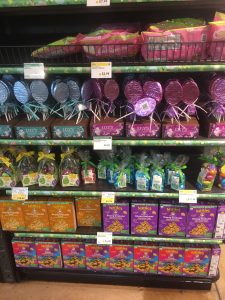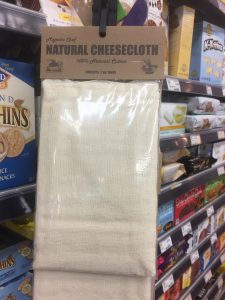There were many significant differences between Whole Foods and Walmart. Whole Foods only had organic, all natural, environmentally friendly products while Walmart had a wide array of products, most of which definitely were not healthy. What I was not expecting though was that Walmart had some of the same brands and healthy choices that Whole Foods had.
Signage: Whole Foods advertised organic, local, “real” (no added chemicals or GMOs), and they had signs stating their core values and quality standards while Walmart advertised low prices, rollbacks, and fresh produce. These differences reveal that Whole Foods is more focused on the the quality of their products and Walmart is more focused on their prices.

Sign at Walmart.

Sign at Whole Foods.
Meat Section: At Whole Foods there were signs on the glass to the meat counter that advertised a “5-Step Animal Welfare Rating” which had a picture of a farmer underneath with “local” written on it. Walmart had no such signs or advertisements and they only had a deli counter and sections with prepackaged meat and poultry. This shows that Whole Foods is focused on freshness while Walmart is focused on convenience.

Meat and Poultry section at Walmart.

Sign on the window of the meat and poultry counter at Whole Foods.
Magazine Racks: The magazine racks at Whole Foods were filled with magazines about food and health whereas Walmart’s magazine racks were filled with tabloids and home improvement magazines. This difference can be attributed to the different types of people shopping at these stores and what each of those demographics are interested in. Whole Foods customers are generally older and wealthier while Walmart’s customers are generally families of lower incomes.

Magazine rack at Walmart.

Magazine rack at Whole Foods.
Snacks: The only candy that I saw at Whole foods was for Easter and they only had bunny graham crackers, chocolate eggs, and lollipops; Walmart on the other hand displayed a wide variety of candy. This difference again can be attributed to their respective demographics; it makes sense that an organic, healthy food store would not carry much candy and kids mostly eat candy so this fits with the fact that Walmart caters better to families.

Candy isle at Walmart.

Candy section at Whole Foods.
Isle Products: Whole Foods had honey droppers, natural cheesecloths, and select teas in the isles while Walmart had pop, energy drinks, and items relating to candy. These products fit well with the stores different focuses and and products.

Hanging isle products at Walmart.

Hanging isle product at Whole Foods.